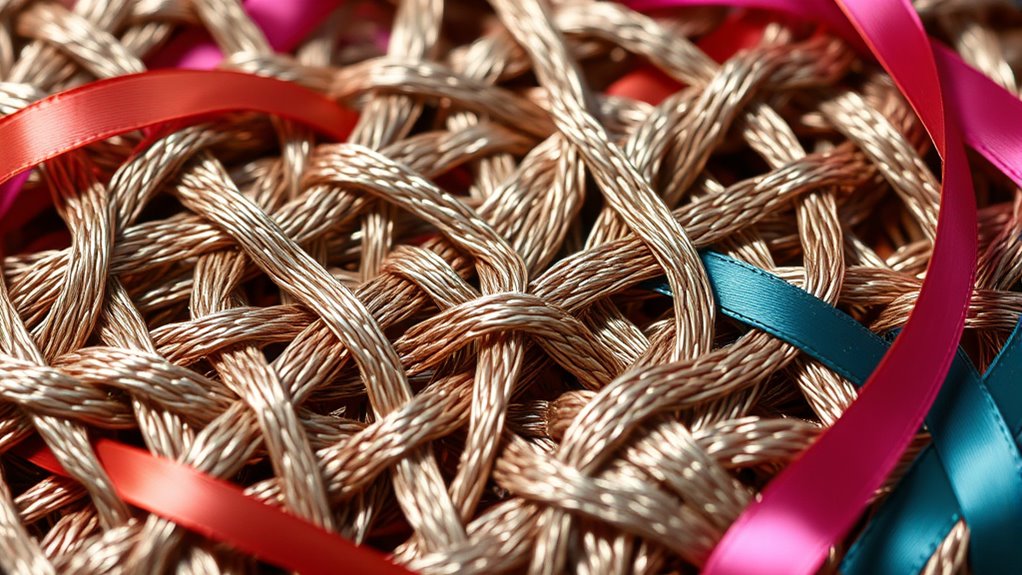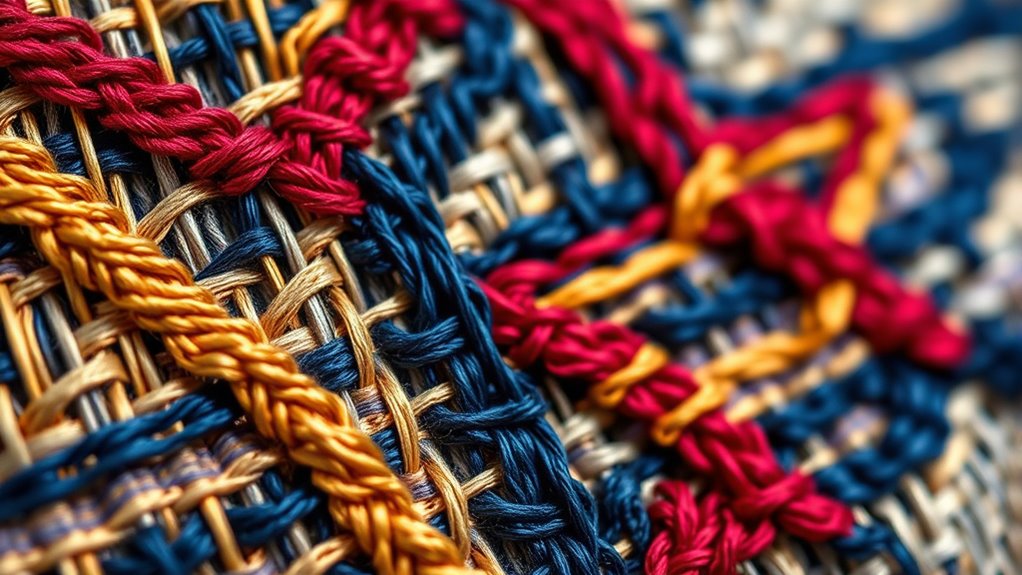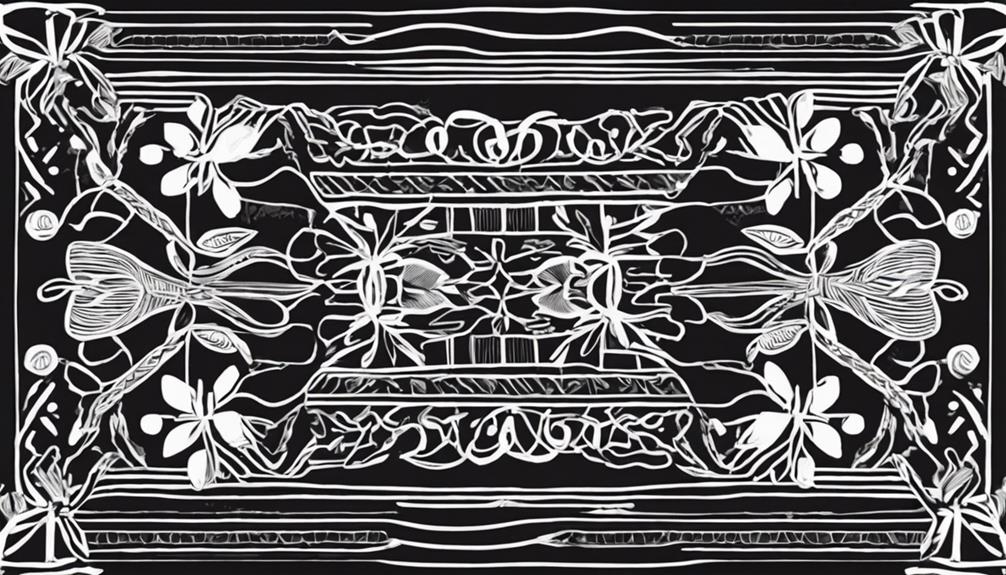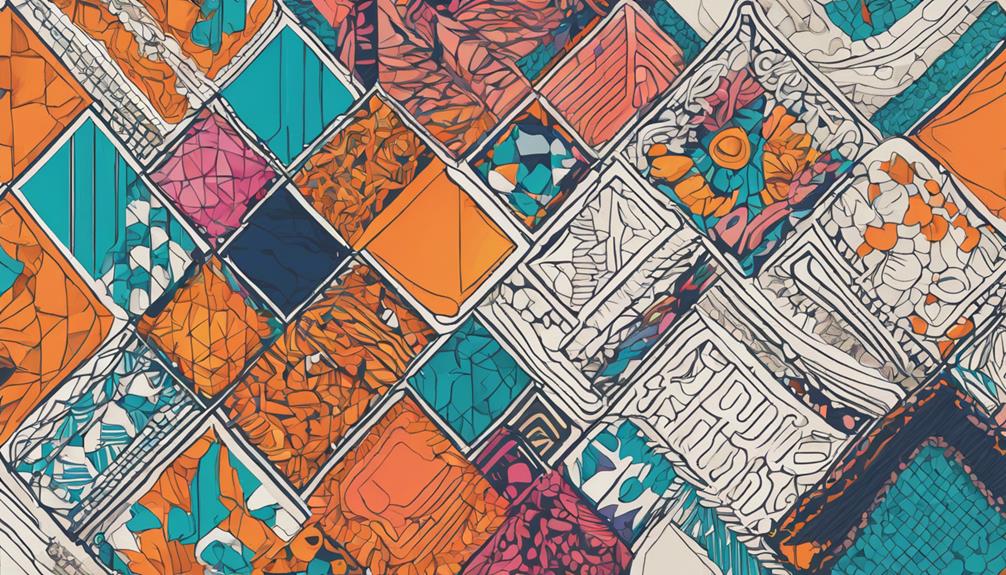Discover seven mind-bending weaving techniques that can transform your business and elevate your textile designs. By exploring styles like double weave, shadow weave, ikat-inspired resist-dyeing, and layered fiber textures, you’ll push creative boundaries and craft eye-catching pieces. Combining traditional methods with modern twists creates stunning visual effects and storytelling opportunities. Keep exploring these innovative approaches, and you’ll open even more possibilities for unique, enthralling textiles that stand out in the market.
Key Takeaways
- Experiment with advanced techniques like double weave or shadow weave to create complex, reversible patterns that surprise viewers.
- Incorporate mixed fiber textures—silk, jute, metallic threads—to add visual depth and tactile interest.
- Combine traditional styles like ikat or tapestry with modern methods for innovative, layered textiles.
- Use layered weaving or illusion techniques to produce dynamic, mind-bending visual effects.
- Explore unconventional structures such as asymmetrical or 3D weaving to challenge traditional design boundaries.

Have you ever wondered how some weavers create intricate patterns that seem almost impossible? The secret often lies in their mastery of fiber textures and a deep understanding of historical weaving styles. These elements serve as the foundation for mind-bending techniques that can transform simple threads into astonishing works of art. When you start exploring different fiber textures, you’ll discover how the material’s properties—whether silky, coarse, or lustrous—affect the final pattern. For example, using fine silk threads can produce delicate, shimmering designs, while rougher fibers like jute lend a more rustic, bold appearance. Understanding how these textures interact enables you to craft textiles with depth and visual interest that captivate the eye. Additionally, incorporating weaving techniques such as tapestry or ikat can further expand your creative toolkit.
Master fiber textures and historical styles to create stunning, intricate textiles that captivate the eye.
Historical weaving styles offer a treasure trove of inspiration and techniques that can elevate your craft. Many traditional methods, such as tapestry weaving or ikat, involve complex processes that create stunning visual effects. Tapestry weaving, for instance, allows you to build detailed images by interlacing different colored fibers carefully. Ikat, on the other hand, involves resist-dyeing fibers before weaving, resulting in beautifully blurred patterns that seem almost alive. These styles aren’t just relics of the past—they’re practical techniques that, when adapted with your twist, can turn simple materials into extraordinary textiles. By studying these ancient methods, you can incorporate their complex structures into your work, pushing the boundaries of what’s possible.
Building on this foundation, you might experiment with combining multiple weaving styles or layering different fiber textures within a single piece. Think of it as a visual dialogue between history and innovation. For example, weaving a traditional ikat pattern using modern, textured fibers can create a striking juxtaposition of old and new. Similarly, exploring lesser-known styles like double weave or shadow weave can give you new tools to create illusion and depth. These techniques often involve manipulating warp and weft in innovative ways, resulting in three-dimensional effects or reversible designs that challenge conventional expectations. The more you familiarize yourself with these methods, the more you’ll realize that weaving isn’t just about creating fabric—it’s about storytelling through textures, patterns, and history.
In essence, by understanding fiber textures and immersing yourself in historical weaving styles, you *access* a world of creative possibilities. Each technique offers a fresh perspective and a chance to craft textiles that are not only beautiful but also rich in history and innovation. When you combine these elements with your unique ideas, you begin to push the limits of what weaving can achieve—transforming simple threads into mind-bending works of art.
Frequently Asked Questions
What Are the Essential Materials for Advanced Weaving Techniques?
When exploring advanced weaving techniques, you need to focus on fiber selection to achieve desired textures and durability. You’ll also want to contemplate loom customization, adapting your equipment for complex designs. High-quality fibers like silk, wool, or specialty blends are essential, along with sturdy, adjustable looms. By choosing the right materials and customizing your loom setup, you set the foundation for innovative, intricate weaving projects that push your skills further.
How Can Beginners Safely Experiment With Complex Weaving Patterns?
Did you know that over 60% of beginners feel intimidated by complex weaving patterns? To experiment safely, start with simple projects and gradually incorporate creative color blending and texture variation techniques. Use high-quality materials and follow tutorials to build confidence. Don’t rush—practice patience and take time to understand each step. This approach helps you develop skills while enjoying the process of exploring new, intricate weaving styles.
Are There Digital Tools to Assist With Intricate Weaving Designs?
You’re wondering if digital tools like digital embroidery or weaving software can help with intricate designs. Absolutely, these tools enable you to visualize complex patterns before weaving, ensuring accuracy and saving time. They often come with tutorials and customizable options, making it easier for you to experiment safely. With digital embroidery and weaving software, you can push your creativity further, trying new, detailed patterns confidently and efficiently.
What Historical Cultures Influenced Modern Mind-Bending Weaving Methods?
Imagine weaving as a tapestry of history, each thread telling a story. You’ll find that ancient textile rituals from cultures like the Incas, Chinese, and Africans have deeply influenced modern mind-bending weaving methods. These traditions embed cultural symbolism in weaving, inspiring innovative techniques today. By exploring these roots, you connect past and present, creating intricate designs that reflect rich histories and spiritual beliefs, pushing contemporary weaving into new, mind-bending domains.
How Do I Troubleshoot Uneven Tension in Complex Weaves?
When troubleshooting uneven tension in complex weaves, start by checking your tension adjustment. Make certain your yarn feeds smoothly and your tension is consistent across all threads. Regularly monitor your tension during weaving, adjusting as needed to prevent variations. Keep your loom maintained, and recheck tension settings if you notice uneven areas. Consistent tension is key to achieving even, professional-looking results in intricate weaves.
Conclusion
Now that you’ve discovered these seven mind-bending weaving techniques, imagine the endless possibilities waiting for you. But this is just the beginning—there’s a whole world of weaving tricks still hidden, ready to challenge your skills and spark your creativity. Will you dare to try the most complex method next? The adventure’s only starting, and your next masterpiece might be closer than you think. Get ready—your weaving journey is about to take an unexpected turn.










